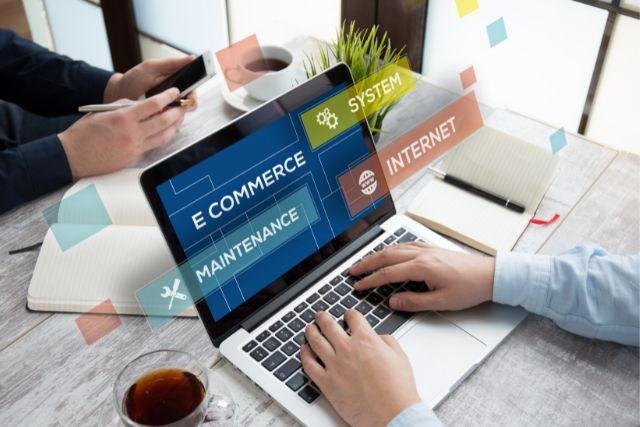E-commerce and online retail have drastically transformed how we shop, offering convenience, variety, and competitive prices at our fingertips. With rapid technological advancements and shifting consumer behaviours, the future of shopping is poised for even more significant changes. This article explores the emerging trends that will shape the future of e-commerce and online retail, highlighting the innovations, challenges, and opportunities that lie ahead.
Table of Contents
Understanding the Current E-Commerce Canvas
Before delving into the future, it’s essential to understand the current state of e-commerce. Online shopping has become a staple in the modern consumer’s life. The rise in smartphone usage, improved internet accessibility, and the convenience of shopping from home have all contributed to the exponential growth of online retail.
Key Players in the Market
Giants like Amazon, Alibaba, and eBay dominate the e-commerce market. However, numerous smaller and niche players are also making their mark. Direct-to-consumer (DTC) brands like Glossier and Warby Parker have disrupted traditional retail by building online solid presences and engaging directly with their customers. These companies prioritize customer experience, offering personalized shopping experiences, easy returns, and vital customer service.
The Role of Social Media
Social media platforms such as Instagram, Facebook, and TikTok are not just for social interaction any more; they have become powerful e-commerce tools. Social commerce allows brands to leverage their social media presence to drive sales directly from their platforms. Influencer marketing, user-generated content, and social shopping features like Instagram Checkout and Facebook Shops have become integral to many brands’ e-commerce strategies.
Emerging Trends Shaping the Future of E-Commerce
As we look ahead, several key trends are emerging that will redefine the future of e-commerce and online retail. These trends focus on enhancing customer experience, optimizing operations, and leveraging technology to gain a competitive edge.
1. Artificial Intelligence and Machine Learning
Artificial Intelligence (AI) and Machine Learning (ML) are at the forefront of technological advancements in e-commerce. These technologies enable personalized shopping experiences by analyzing customer data and predicting future behaviour. AI-powered chatbots, for example, provide 24/7 customer support, helping to answer queries, provide product recommendations, and streamline the checkout process.
ML algorithms help in inventory management by predicting demand and optimizing stock levels. This reduces the risk of overstocking or stockouts, improving both customer satisfaction and profitability. Additionally, AI-driven tools can enhance search functionalities on e-commerce websites, making it easier for customers to find what they’re looking for.
2. Augmented Reality (AR) and Virtual Reality (VR)
Augmented Reality (AR) and Virtual Reality (VR) are revolutionizing online shopping by bridging the gap between digital and physical experiences. These technologies allow customers to try on clothes virtually, see how furniture would look in their home, or explore products in a 3D environment. Major retailers like IKEA and Sephora have already implemented AR features in their apps, allowing for a more interactive and immersive shopping experience.
The future of AR and VR in e-commerce looks promising as these technologies become more sophisticated and accessible. We can expect to see more retailers adopting AR and VR to enhance product visualization, reduce return rates, and increase customer satisfaction.
3. Voice Commerce
Voice commerce, driven by the rise of smart speakers like Amazon Echo and Google Home, is another trend gaining traction in e-commerce. Voice assistants enable customers to make purchases, track orders, and receive personalized recommendations simply by using their voice. This hands-free, convenient shopping method is particularly appealing to busy consumers and those looking for quick, efficient transactions.
As voice recognition technology improves, voice commerce is expected to become a more significant part of the e-commerce landscape. Retailers need to optimize their content for voice search and develop strategies to integrate voice shopping into their existing e-commerce platforms.
4. Sustainability and Ethical Shopping
Today’s consumers are more conscious of the environmental and social impact of their purchases. As a result, sustainability has become a crucial factor in the future of e-commerce. Brands are increasingly focusing on eco-friendly packaging, carbon-neutral shipping, and ethical sourcing of products. Companies like Patagonia and Everlane are leading the way by promoting transparency and sustainability in their supply chains.
The demand for sustainable products and practices is expected to grow, and e-commerce businesses that prioritize sustainability will likely have a competitive advantage. Retailers should consider incorporating sustainable practices into their operations and clearly communicating these efforts to their customers.
5. Omnichannel Retailing
Omnichannel retailing integrates online and offline shopping experiences to provide a seamless customer journey. It combines the convenience of e-commerce with the tactile experience of brick-and-mortar stores. Retailers like Nike and Apple have successfully implemented omnichannel strategies, offering services like click-and-collect, curbside pickup, and in-store returns for online purchases.
The future of shopping lies in a cohesive omnichannel strategy where customers can move effortlessly between online and offline channels. Retailers must invest in technologies that integrate various touchpoints and provide a consistent, personalized shopping experience.
6. Subscription Models
Subscription-based models have gained popularity in recent years, providing consumers with regular deliveries of their favourite products. Companies like Dollar Shave Club, Birchbox, and HelloFresh have built their businesses around subscription services, offering convenience and personalized experiences to their customers.
This trend is expected to continue as more consumers seek hassle-free, recurring purchases. Retailers can capitalize on this trend by offering subscription options for their products, ensuring a steady revenue stream and building customer loyalty.
7. Blockchain for Secure Transactions
Blockchain technology is poised to revolutionize e-commerce by providing secure, transparent, and tamper-proof transactions. This technology can enhance payment security, prevent fraud, and protect customer data. Moreover, blockchain can be used to track products throughout the supply chain, ensuring authenticity and transparency, which is crucial for building trust with consumers.
As more retailers and payment processors adopt blockchain technology, we can expect increased trust and security in online transactions, potentially reducing fraud and increasing consumer confidence.
Challenges Facing the Future of E-Commerce
While the future of e-commerce holds immense potential, it is not without its challenges. Addressing these challenges will be critical for retailers looking to succeed in the evolving online retail landscape.
1. Cybersecurity Threats
With the rise of e-commerce comes an increase in cybersecurity threats. Online retailers are prime targets for hackers looking to steal sensitive customer information or disrupt operations. As cyber threats become more sophisticated, retailers must invest in robust cybersecurity measures to protect their customers and their businesses.
2. Increased Competition
The low barrier to entry in e-commerce means that competition is fierce. Retailers must differentiate themselves through exceptional customer service, unique product offerings, or competitive pricing to stand out in a crowded market. Building a strong brand identity and maintaining customer loyalty are crucial for long-term success.
3. Logistics and Supply Chain Challenges
Efficient logistics and supply chain management are critical for meeting customer expectations regarding delivery speed and reliability. However, managing these logistics can be challenging, especially for small and medium-sized businesses. Issues such as inventory management, shipping costs, and international regulations can complicate operations and impact profitability.
4. Adapting to Changing Consumer Preferences
Consumer preferences are constantly evolving, and retailers must be agile enough to adapt. Trends like ethical shopping, personalization, and convenience continue to shape consumer behaviour. Retailers need to stay ahead of these trends, leveraging data and analytics to understand their customers better and tailor their offerings accordingly.
Opportunities for Growth in E-Commerce
Despite the challenges, there are numerous opportunities for growth in the e-commerce sector. By leveraging technology and innovation, retailers can enhance their offerings, improve customer experiences, and expand their market reach.
1. Expanding into New Markets
The global nature of e-commerce allows retailers to reach customers in new and emerging markets. Countries like India, Brazil, and Southeast Asian nations are experiencing rapid growth in online shopping, presenting lucrative opportunities for retailers willing to expand internationally.
2. Leveraging Data and Analytics
Data is the new currency in e-commerce. Retailers can gain valuable insights into customer behavior, preferences, and trends by leveraging data and analytics. This information can be used to personalize marketing efforts, optimize inventory, and improve overall customer experience.
3. Investing in Technology
Investing in emerging technologies like AI, AR, VR, and blockchain can give retailers a competitive edge. These technologies can enhance the shopping experience, improve operational efficiency, and build customer trust and loyalty. Retailers who embrace technology and innovation will be well-positioned to succeed in the future of e-commerce.
4. Enhancing Customer Experience
Customer experience is a key differentiator in e-commerce. Retailers who prioritize exceptional customer service, offer personalized shopping experiences, and provide hassle-free returns will stand out in a competitive market. Focusing on customer satisfaction and building strong relationships will be crucial for long-term success.
Conclusion: Preparing for the Future of Shopping
The future of shopping is digital, dynamic, and driven by technology and innovation. E-commerce and online retail will continue to evolve, shaped by emerging trends such as AI, AR, VR, voice commerce, and sustainability. While challenges like cybersecurity threats, increased competition, and changing consumer preferences exist, there are ample opportunities for growth for those who are prepared to adapt and innovate.
Retailers who invest in technology, prioritize customer experience, and embrace sustainable practices will be well-positioned to thrive in the future of e-commerce. As the landscape continues to evolve, staying informed and agile will be key to navigating the trends and seizing the opportunities that lie ahead.
FAQs
1. What are the key trends shaping the future of e-commerce?
The future of e-commerce is being shaped by trends such as AI and machine learning, augmented and virtual reality, voice commerce, sustainability, omnichannel retailing, subscription models, and blockchain technology.
2. How can retailers prepare for the future of online shopping?
Retailers can prepare by investing in emerging technologies, focusing on customer experience, expanding into new markets, leveraging data and analytics, and adopting sustainable practices.
3. What challenges do online retailers face in the future?
Challenges include cybersecurity threats, increased competition, logistics and supply chain complexities, and adapting to changing consumer preferences.
4. How is technology impacting the e-commerce landscape?
Technology like AI, AR, VR, and blockchain is enhancing the shopping experience, improving operational efficiency, and building trust and security in online transactions.
5. Why is sustainability important in e-commerce?
Consumers are increasingly conscious of the environmental and social impact of their purchases, making sustainability a crucial factor in e-commerce. Brands that prioritize sustainability will likely have a competitive advantage.
6. What opportunities exist for growth in e-commerce?
Opportunities for growth include expanding into new markets, leveraging data and analytics for better decision-making, investing in technology, and enhancing customer experience to build loyalty and increase sales.







